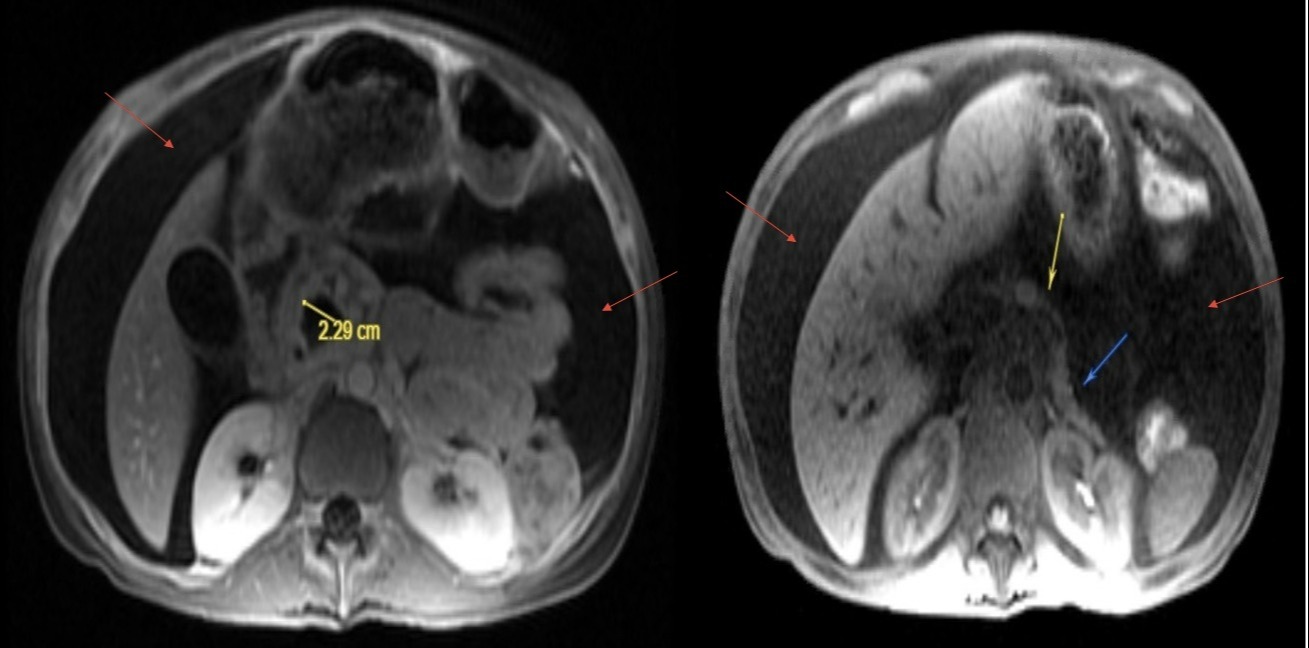Back
Poster Session D - Tuesday Morning
D0066 - Recurrent Pancreatitis Secondary to Adderall Use With Pancreatic Ascites: A Sight Typically Unseen
Tuesday, October 25, 2022
10:00 AM – 12:00 PM ET
Location: Crown Ballroom
- SS
Shabari M. Shenoy, MBBS
Icahn School of Medicine at Mount Sinai Morningside-West
new york, NY
Presenting Author(s)
Shabari M. Shenoy, MBBS1, Jenny Dave, MD2, Edward Lung, MD3, Kimberly Cavaliere, MD4
1Icahn School of Medicine at Mount Sinai Morningside-West, New York, NY; 2Mount Sinai Morningside-West- Beth Israel Hospital, New York, NY; 3Mount Sinai Morningside and Mount Sinai West, New York, NY; 4Mount Sinai, New York, NY
Introduction: Pancreatic ascites is a rare disease with a prevalence of 3.5% resulting from pancreatic duct injury. While small ascites resolves spontaneously, large volume, persistent ascites can cause significant morbidity and mortality. We present a case of pancreatic ascites in a patient with recurrent pancreatitis from Adderall use.
Case Description/Methods: 38-year-old female with attention deficit hyperactive disorder (ADHD), remote alcohol use, and recurrent pancreatitis complicated by pseudocyst and ascites presented with acute on chronic epigastric pain. Her last reported alcohol use was two years ago. Home medications included Adderall (amphetamine and dextroamphetamine) and benzodiazepines. Physical examination revealed normal vital signs, severe cachexia and peripheral edema. Abdomen was distended with epigastric tenderness. Pertinent labs included hemoglobin of 10.8g/dl, calcium 7.6mg/dl, albumin 1.7g/dl and a lipase of 462U/l. Bilirubin, transaminases, alkaline phosphatase and INR were normal. Quantitative immunoglobulins, IgG4, triglycerides and thyroid stimulating hormone were within normal limits. Blood alcohol and phosphatidylethanol (PETH) levels were negative. Previous CT scan demonstrated pancreatic head cyst (4.6cm), stable pseudocysts in the head and body, peripancreatic inflammation and large abdominal ascites. MRCP this admission revealed pancreatic head fluid collection decreased in size (2.3cm), consistent with walled off necrosis. Diagnostic paracentesis was significant for: WBC 93 cells/mm3, PMN 25%, RBC 2050 cells/mm3, protein 1.9g/dl, lactate dehydrogenase 102U/L, amylase 1496U/L and a serum ascites-albumin gradient (SAAG) < 1.1. An endoscopic retrograde cholangiopancreatography (ERCP) was pursued due to suspicion for pancreatic ascites which showed abrupt cut off of the pancreatic duct in the head, without filling of the pancreatic duct in the body or tail likely due to stricture. A pancreatic stent was placed into the ventral pancreatic duct to maintain patency with plan for endoscopic ultrasound examination (EUS) to exclude obstructive pathology.
Discussion: Pancreatic ascites is often seen with recurrent pancreatitis commonly of alcoholic etiology. Our patient had recurrent pancreatitis and ascites due to chronic adderall use. While pancreatitis from adderall use is rare, presentation with ascites can pose a diagnostic challenge. Hence, clinicians should familiarize themselves with early diagnosis and endoscopic management which improves prognosis in this rare disease.

Disclosures:
Shabari M. Shenoy, MBBS1, Jenny Dave, MD2, Edward Lung, MD3, Kimberly Cavaliere, MD4. D0066 - Recurrent Pancreatitis Secondary to Adderall Use With Pancreatic Ascites: A Sight Typically Unseen, ACG 2022 Annual Scientific Meeting Abstracts. Charlotte, NC: American College of Gastroenterology.
1Icahn School of Medicine at Mount Sinai Morningside-West, New York, NY; 2Mount Sinai Morningside-West- Beth Israel Hospital, New York, NY; 3Mount Sinai Morningside and Mount Sinai West, New York, NY; 4Mount Sinai, New York, NY
Introduction: Pancreatic ascites is a rare disease with a prevalence of 3.5% resulting from pancreatic duct injury. While small ascites resolves spontaneously, large volume, persistent ascites can cause significant morbidity and mortality. We present a case of pancreatic ascites in a patient with recurrent pancreatitis from Adderall use.
Case Description/Methods: 38-year-old female with attention deficit hyperactive disorder (ADHD), remote alcohol use, and recurrent pancreatitis complicated by pseudocyst and ascites presented with acute on chronic epigastric pain. Her last reported alcohol use was two years ago. Home medications included Adderall (amphetamine and dextroamphetamine) and benzodiazepines. Physical examination revealed normal vital signs, severe cachexia and peripheral edema. Abdomen was distended with epigastric tenderness. Pertinent labs included hemoglobin of 10.8g/dl, calcium 7.6mg/dl, albumin 1.7g/dl and a lipase of 462U/l. Bilirubin, transaminases, alkaline phosphatase and INR were normal. Quantitative immunoglobulins, IgG4, triglycerides and thyroid stimulating hormone were within normal limits. Blood alcohol and phosphatidylethanol (PETH) levels were negative. Previous CT scan demonstrated pancreatic head cyst (4.6cm), stable pseudocysts in the head and body, peripancreatic inflammation and large abdominal ascites. MRCP this admission revealed pancreatic head fluid collection decreased in size (2.3cm), consistent with walled off necrosis. Diagnostic paracentesis was significant for: WBC 93 cells/mm3, PMN 25%, RBC 2050 cells/mm3, protein 1.9g/dl, lactate dehydrogenase 102U/L, amylase 1496U/L and a serum ascites-albumin gradient (SAAG) < 1.1. An endoscopic retrograde cholangiopancreatography (ERCP) was pursued due to suspicion for pancreatic ascites which showed abrupt cut off of the pancreatic duct in the head, without filling of the pancreatic duct in the body or tail likely due to stricture. A pancreatic stent was placed into the ventral pancreatic duct to maintain patency with plan for endoscopic ultrasound examination (EUS) to exclude obstructive pathology.
Discussion: Pancreatic ascites is often seen with recurrent pancreatitis commonly of alcoholic etiology. Our patient had recurrent pancreatitis and ascites due to chronic adderall use. While pancreatitis from adderall use is rare, presentation with ascites can pose a diagnostic challenge. Hence, clinicians should familiarize themselves with early diagnosis and endoscopic management which improves prognosis in this rare disease.

Figure: MRCP images revealing large volume ascites (red arrow), walled off necrosis in the pancreatic head (yellow arrow) and peripancreatic inflammation (blue arrow)
Disclosures:
Shabari Shenoy indicated no relevant financial relationships.
Jenny Dave indicated no relevant financial relationships.
Edward Lung indicated no relevant financial relationships.
Kimberly Cavaliere indicated no relevant financial relationships.
Shabari M. Shenoy, MBBS1, Jenny Dave, MD2, Edward Lung, MD3, Kimberly Cavaliere, MD4. D0066 - Recurrent Pancreatitis Secondary to Adderall Use With Pancreatic Ascites: A Sight Typically Unseen, ACG 2022 Annual Scientific Meeting Abstracts. Charlotte, NC: American College of Gastroenterology.
